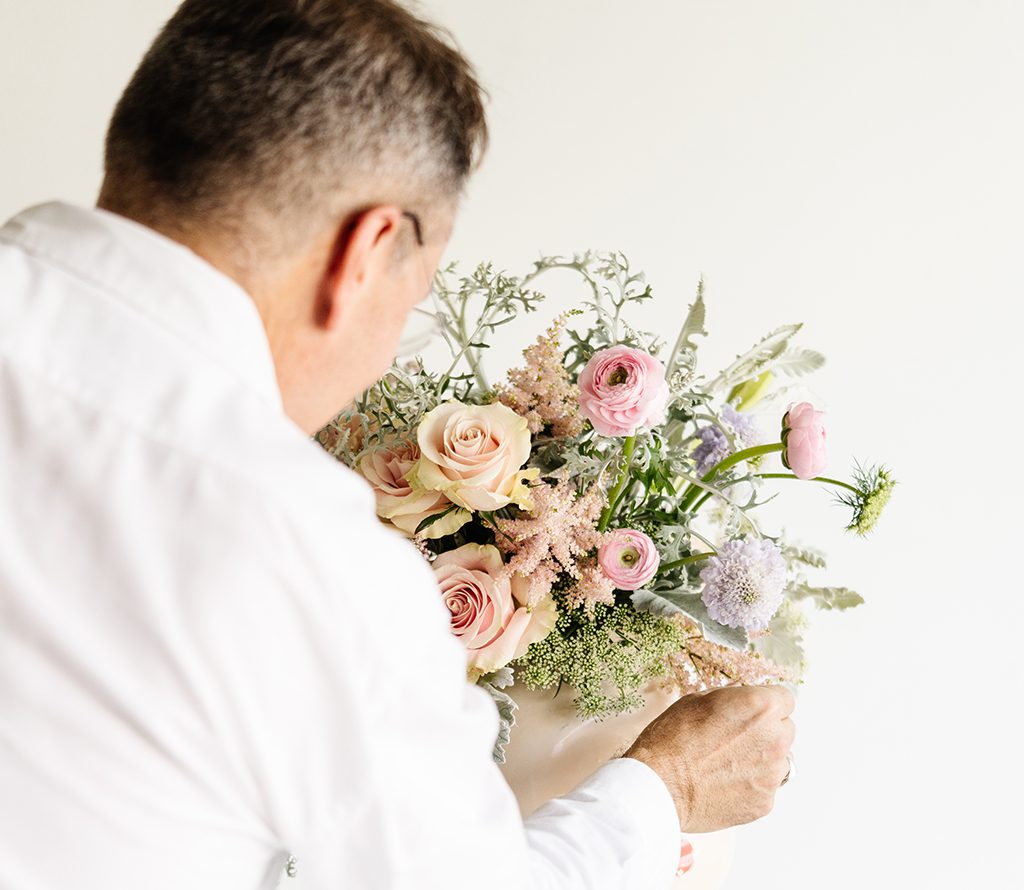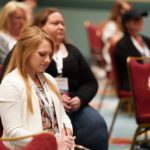
Talmage McLaurin, AIFD, puts the finishing touches on an arrangement that embodies the ephemeral floral trend. McLaurin, who has nearly three decades of experience spotting floral trends, will share his 2023 forecast at SAF Orlando 2022.
Talmage McLaurin, AIFD, has established a career identifying and understanding floral trends. He spots the up-and-coming aesthetics — whether he likes them or not — and has successfully forecasted trends that influence business and marketing decisions and drive customers to purchase flowers.

Talmage McLaurin, AIFD
His career began inside his parents’ retail floral shop, where he worked as a teenager. After college, where he studied psychology and learned to appreciate the “whys” and cause and effects of human decision-making, he developed a reputation in floral publishing, reporting and trendspotting. In 2002 he conceptualized the American Floral Trends Forecast and remained involved in its publication until 2014.
Now, his annual trend forecast informs flower growers and importers, and most recently, Esmeralda Farms, where he serves as creative director. His trendspotting captures every part of the industry from production, marketing and business sales to the newest designs and color palettes.
McLaurin will bring his nearly three decades of experience to SAF Orlando 2022, the Society of American Florists’ 137th annual convention Sept. 6-8 in Orlando, Florida, where during an all industry session, he will reveal six of the most compelling floral trends for 2023. In a follow up session, “Flower Trends Forecast in Action: Profitable, Trend Forward Designs,” three designers will translate those six trends into profitable, everyday event, gifting and sympathy designs.
Without giving your forecast away, can you hint at what the report will offer for 2023?
I’m going to offer some food for thought on how important it is to carefully examine what’s happening socially in the world when we look to create new color palettes and styles — because that is a way to get it right. If you just rely on your own sense of style, you might get it wrong. It’s important to look around.
Where do you look for inspiration and design?
Everywhere. If you really want to capture what people are interested in, you look in fashion, interior design, graphics, and you also heavily consider the world at large. All the trends I talk about now, I say, they have to be viewed through COVID-colored glasses.
What sources do you regularly use?
I work heavily with Pantone to form the color stories we tell about flowers. So the stories we pull together, the palettes we pull together, are not only valid in our flower shops, but they do consider all of the colors of the world.
Are there any mass media sources you also rely on?
I’m addicted to Instagram. Just start following florists. By spending time there you can see trends evolving not just in the U.S. but worldwide.
Can you share an example of something you’re noticing on Instagram?
One of the surprising things that I’m seeing a lot of on Instagram are flowers void of the color green. All the foliage color is gone, so they are coming up with a new palette, almost confectionary, almost candy like.
How do you separate your likes and dislikes from your validation of a new trend?
From my years of working in publishing and with clients, I know you have to key into what they are attracted to. It would make for a super boring magazine, and become very one note, if all I did was what I personally liked.
Can you describe your style?
It’s traditional to very contemporary. Hopefully I’m a bit of a chameleon. Lately I’ve been fascinated with a dystopian, moody feel that includes a combination of fresh and dry flowers. It’s not terribly uplifting.
Is that your COVID-colored lens?
There is certainly a reaction to the world. There is a dystopian view of the world. COVID has not been a fun party.
What’s your biggest tip for staying on trend and attracting buyers?
Imagine your message is time sensitive. What your customers want is something new and different, something that excites them, that they haven’t seen before. And to create that is sometimes a challenge. One thing about trends, they are not revolutionary — they are evolutionary.
How do we do that? Are there solutions?
We can teach our customers to make their flowers last. After enjoying a stem or bouquet they can dry it, press it, keep it. We can also enjoy flowers in a small way every day. They don’t have to spend too much money or go outside their budget — that way they can purchase and enjoy them regularly. Sometimes there is power in one stem.
What tools or resources do you recommend for aspiring floral designers?
It is always good to review the history of design. It’s not so much that you want to emulate old fashion design, but if you understand what was before, then you can understand why and how something is veering from the traditional.
Looking for more design inspiration at SAF Orlando 2022? Check out the Sylvia Cup Design Competition; an Experience Zone with Sarah Campbell who will feature five, low-labor designs; and a special hands-on session with Campbell on floral installations that increase sales.
Sarah Sampson is a contributing writer for the Society of American Florists.


